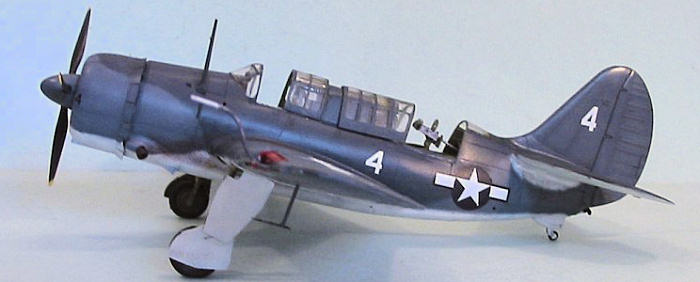
Accurate Miniatures 1/48 SB2C-1 Helldiver
| KIT #: | ? |
| PRICE: | $39.95 MSRP |
| DECALS: | See review |
| REVIEWER: | Tom Cleaver |
| NOTES: | Reboxed ProModeler kit with upgrade parts. |

| HISTORY |
There is likely no airplane that ever served in the American armed forces
that is a better example of the kind of military-industrial "boondoggle" that
President Eisenhower later warned against, calling it the "military-industrial
complex." The airplane could never meet the original specifications it was
created to meet, and was not much - if any - of an advance over the airplane it
replaced in terms of war-fighting ability. It didnít have the range, the speed
or the firepower to actually do its job. As Jim Hardy of VF-17 once told me,
when they sent VB-17 off the "Hornet" in the spring of 1945, "we lost nothing in
terms of offensive ability. Our Hellcats could carry more bombs further, faster,
and then fight when we got there - none of which the Helldiver was capable of."
Yet even as squadrons were being downsized to 12-14 aircraft (from 36) to make
room for more capable aircraft on carrier decks, Helldivers were pouring out of
the factory in Columbus, Ohio, the majority of which were delivered to aircraft
parks they never left. 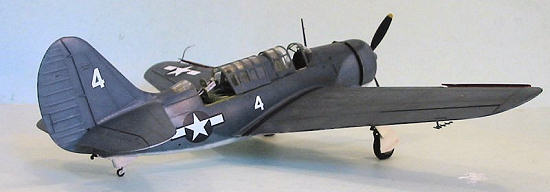 The
flying ability of the airplane was thoroughly deserving of the general belief in
the naval aviation community that the designation SB2C stood for "sumbitch
second class."
The
flying ability of the airplane was thoroughly deserving of the general belief in
the naval aviation community that the designation SB2C stood for "sumbitch
second class."
The Curtiss-Wright SB2C "Helldiver" was to be the U.S. Navy's definitive dive bomber in what everyone in the Navy expected would be the coming war with Japan. The winner of a 1938 design competition that required the airplane to have an internal bomb bay capable of carrying 2,000 pounds of bombs, and an airframe that would be able to ride a carrier elevator that was 40' x 48' - the dimensions of the coming "Essex" class of fleet carriers. This was a formidable challenge, to design an airplane with sufficient performance, and still keep its size down to such dimensions. For Curtiss, the airplane was to be the fulfillment of all the "Helldivers" that had come before it, beginning with the F8C in 1931, and was to be markedly superior to the Douglas SBD "Dauntless" that was just coming off the drawing boards in late 1938.
The result was a short-coupled airplane that would finally grow a huge vertical fin and rudder, as well as oversized horizontal stabilizer and elevators, in order to provide sufficient control in a fuselage as short as that in the SB2C.
Because of the looming war, the SB2C would be one of the first designs to be ordered into production "off the drawing board," before the flight of the first prototype, with 370 SB2C-1s ordered on May 15, 1939. Due to Curtiss' commitments for the P-40 at the Buffalo plant, a new plant in Columbus, Ohio had to be built to handle production of the Helldiver while the first prototype was being built.
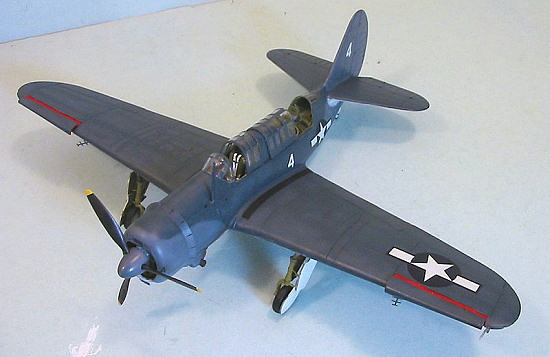 At the point of the
first production order, the design was far from ready for any sort of
production. Wind tunnel tests revealed the original wing design had a stalling
speed that was far too high for a carrier-based aircraft, which resulted in a
redesign (and concomitant delay) that increased the total wing area by 10
percent, while Handley-Page slats were added for low-speed controllability.
At the point of the
first production order, the design was far from ready for any sort of
production. Wind tunnel tests revealed the original wing design had a stalling
speed that was far too high for a carrier-based aircraft, which resulted in a
redesign (and concomitant delay) that increased the total wing area by 10
percent, while Handley-Page slats were added for low-speed controllability.
The XSB2C-1 was rolled out on December 13, 1940, and first flew on December 18. Test pilot Lloyd Childs reported that the predicted stability problems had not been solved, though they had been somewhat mollified. The crash of the prototype in February 1941 set the program back while it was rebuilt. Testing resumed in May 1941, with a larger - though not yet definitive - tail. The wing failed in flight on December 21, 1941, completely destroying the prototype before it could undergo Navy trials.
The first production SB2C-1 rolled out on June 30, 1942. "Gremlins" in the design slowed production and forced Curtiss to retain the early production aircraft for further trials, with the first production airplane crashing in a dive in January 1943, the result of wing failure. Addition of self-sealing fuel tanks, armor, and radar led to an increase in weight, with top speed falling from 368 mph to 322 mph, while landing speed rose to 91 mph. At this point, the SB2C-1 was now underpowered with an R-2600-8 providing only 1,700 h.p. for takeoff, making its operation from even decks as large as the "Essex"class marginal, and looked no more ready to go to sea than when the first prototype had flown in 1940.
SB2C-1s were forbidden to dive without use of the flaps, which were only marginally-effective. With the addition of radar, armor, self-sealing fuel tanks, empty weight rose by 3,000 pounds, with the result that top speed dropped from 320 m.p.h. to 280 m.p.h., and landing speed increased by 10 m.p.h. The "Mod I" post-production program set up in the fall of 1942 dealt with internal fixes and control surface modifications. In the Spring of 1943, the "Mod II" program began, which made some 800 technical changes in each airplane. The short-coupled design - which had been forced in the original specification to fit the airplane to the carrier elevators - meant the Helldiver was directionally-unstable even with the now-huge vertical fin and rudder. A total of 971 SB2C-1s were produced, with the first ones delivered to VS-9 on December 15,1942.
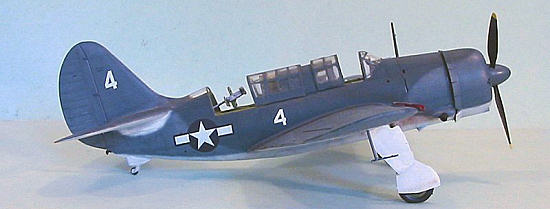 As it happened, the
squadron that became most involved in the service testing of the SB2C-1, and
which would be destined to be the only unit to take the first Helldiver into
combat, was VB-17, which "stood up" on January 1, 1943, part of the new Air
Group 17 destined for the new Essex class carrier Bunker Hill. Air Group
17 was to be the most modern group in the Navy at that time, with VF-17 equipped
with the new F4U-1 Corsair, which gave as much trouble as did the Helldiver. It
wasnít long until the squadron had written "The Helldiver Driverís Song" which
gives an indication of the problems encountered with the airplane soon to be
known as "The Beast" (To the tune, "My Bonnie Lies Over The Ocean"):
As it happened, the
squadron that became most involved in the service testing of the SB2C-1, and
which would be destined to be the only unit to take the first Helldiver into
combat, was VB-17, which "stood up" on January 1, 1943, part of the new Air
Group 17 destined for the new Essex class carrier Bunker Hill. Air Group
17 was to be the most modern group in the Navy at that time, with VF-17 equipped
with the new F4U-1 Corsair, which gave as much trouble as did the Helldiver. It
wasnít long until the squadron had written "The Helldiver Driverís Song" which
gives an indication of the problems encountered with the airplane soon to be
known as "The Beast" (To the tune, "My Bonnie Lies Over The Ocean"):
Oh Mother, dear Mother, take down that blue star.
Replace it with one that is gold.
Your son is a Helldiver driver, heíll never be 30 years old.
My body lies under the ocean; my body lies under the sea.
My body lies under the ocean, wrapped up in an SB2C!
CO LCDR James "Moe" Vose was a veteran of VB-8 at Midway and Santa Cruz. He first became aware of the Squadronís new aircraft on March 1,1943, when he saw a number of unidentified aircraft at Norfolk NAS. Upon further investigation, he was told they were going to VB-17. Within a week, the squadronís pilots had checked out in the new aircraft. Within a month, four had been lost, resulting in the death of one pilot. In July, VB-17 and VS-17 were combined into one unit when scouting squadrons were discontinued. That June, they deployed aboard Bunker Hill for training in the Caribbean, where it was soon obvious that the SB2C-1 was nowhere near ready for a carrier deck. On a hard landing, the Helldiver would buckle just behind the rear cockpit. Tailwheels were frequently lost on impact with the deck. Between May and October 1943, VB-17 lost an average of one aircraft a month to the gremlins that infested the Helldiver. Finally fully equipped with the first Mod III SB2C-1s, the squadron seemed to have "tamed the beast" by the time they deployed to the Western Pacific that September. Even with all this, the airplane was underpowered with all the added weight, and getting off the flight deck was always a hair-raising experience.
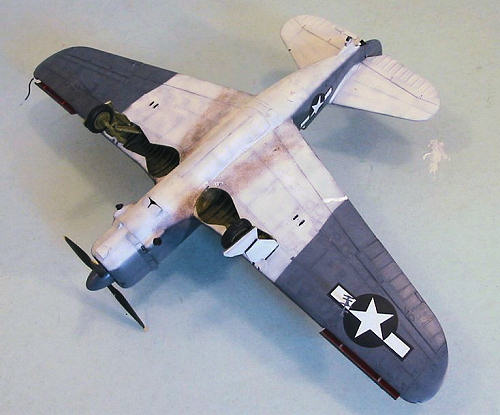 On November 11, Bunker
Hill, in company with the Essex and the light carrier Independence, was directed
to strike the main Japanese base at Rabaul. Task Force 38, commanded by RADM
Sherman aboard the Saratoga with the light carrier Princeton had struck on
November 5. This second strike would also include Task Force 38, as well as the
three new carriers. The air crews of VB-17 who would form the heart of Bunker
Hillís strike faced their first combat mission with a feeling of definite dread.
On November 11, Bunker
Hill, in company with the Essex and the light carrier Independence, was directed
to strike the main Japanese base at Rabaul. Task Force 38, commanded by RADM
Sherman aboard the Saratoga with the light carrier Princeton had struck on
November 5. This second strike would also include Task Force 38, as well as the
three new carriers. The air crews of VB-17 who would form the heart of Bunker
Hillís strike faced their first combat mission with a feeling of definite dread.
Vose led 23 SB2C-1s in Helldiver "B-4." The mission started badly when "B-27" crashed on takeoff due to engine failure.
Arriving over Simpson Harbor, which was full of ships, Air Group 17 was met by a large force of Zeros. The Hellcats of VF-18 were immediately involved in dogfights over the harbor while the bombers went after the shipping. The second division dove first, while Vose led his Helldivers to the far side of the harbor and attacked cruisers and destroyers maneuvering offshore. A cruiser and three destroyers were hit, with one destroyer sunk.
After 20 minutes, it was time to withdraw. While most escaped safely, B-5, flown by Lt. Chinn, was chased by four Zeros.
The Japanese did not let the task force escape. Shortly after the strike returned, a Japanese strike was detected on the radar. The Corsairs of VF-17 that had flown up from Rendova to provide extra cover, and Hellcats of VF-18, as well as the Hellcats of the other four carriers, were soon heavily engaged. ENS W.D. Harris, with his gunner radioman D.W. Thompson, were returning from an antisubmarine patrol when they ran into four D3A "Val" divebombers attacking the task force. Harris shot down one Val and damaged another. Harris would later transfer to fighters and become an ace in 1945 flying Corsairs from the Essex.
VB-17 lost four Helldivers on November 11, including the crash on takeoff, one each to fighters and flak over Rabaul and one jettisoned after landing with extensive battle damage. The SB2C-1 had met the test of combat. Over the next four months, VB-17 supported the Marines at Tarawa, struck Nauru and Kavieng, and participated in the strike against Truk in February, finishing off with the invasion of Kwajalein and strikes against Tinian in the Marianas before completing their tour on March 4,1944.
| THE KIT |
Several modelers, including your humble reviewer, have attempted over the years to do the early Helldiver from the ProModeler kit after it was released in 1997. In my own case, I did an SB2C-1C by replacing the perforated photoetch flaps and divebrakes with .010 Evergreen sheet, and substituting a prop from an Otaki Corsair with the spinner from a Tamiya Beaufighter. The open glass area behind the pilotís canopy was done with s sheet of Butyrate smash molded to create the proper shape. The result was "close, but no cigar."
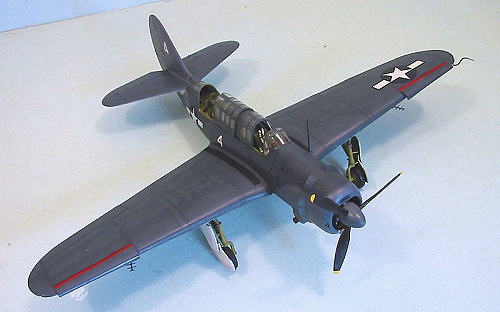 Unfortunately, thatís
about as good as you can do with this Accurate Miniatures release of the
ProModeler SB2C-4 kit with whatís provided. While solid metal divebrakes and
flaps are there, they arenít correct for any Helldiver earlier than the
mid-production SB2C-3, since they kept the perforated trailing edge of the upper
dive brakes that was only introduced at this point. The kit also has a
three-bladed prop, taken from the TBF-1C Avenger; this isnít actually right,
since it is a Hamilton-Standard prop rather than a Curtiss Electric, but with
the hub hidden inside the spinner that comes with the kit, the blades themselves
are "close enough" in shape to the Curtiss prop used by the SB2C-1 and SB2C-1C.
Unfortunately, thatís
about as good as you can do with this Accurate Miniatures release of the
ProModeler SB2C-4 kit with whatís provided. While solid metal divebrakes and
flaps are there, they arenít correct for any Helldiver earlier than the
mid-production SB2C-3, since they kept the perforated trailing edge of the upper
dive brakes that was only introduced at this point. The kit also has a
three-bladed prop, taken from the TBF-1C Avenger; this isnít actually right,
since it is a Hamilton-Standard prop rather than a Curtiss Electric, but with
the hub hidden inside the spinner that comes with the kit, the blades themselves
are "close enough" in shape to the Curtiss prop used by the SB2C-1 and SB2C-1C.
The decals are so-so, with the fuselage national insignia being two sizes too large, though the sheet also provides serial numbers for all the SB2C-1s flown by VB-17 on the Rabaul raid. No stencils are provided, with the modeler informed they can get these from an Aeromaster sheet that is no longer in production.
Perhaps the biggest problem is that the kit purports to be a VB-17 Helldiver as flown at the Rabaul raid, which would make it an SB2C-1, though the kit advertises itself as being an SB2C-1C.
Overall, if your goal is an early Helldiver, either an SB2C-1 or SB2C-1C, the fact is You Cannot Get There From Here with what comes in the kit, not without a lot of extra effort.
Herewith, the tale of converting an SB2C-4 to an SB2C-1.
| CONSTRUCTION |
Here are the major differences between the SB2C-4 as provided in the kit, and an SB2C-1 or SB2C-1C:
1. Flaps and dive brakes are non-perforated on early Helldivers.
2. Area behind pilotís cockpit is visible through canopy windows and the gas tank between pilotís and gunnerís cockpits is visible.
3. Turtleback between pilotís and gunnerís cockpits is open without bulkheads, so that the entire structure of the life raft compartment can be seen.
4. The sliding canopy over the gunnerís cockpit does not have the modifications of the SB2C-4 canopy for lessening turbulence; the sliding area of the fuselage to either side of the gunnerís cockpit must be modified with the roller removed from the canopy and the railing changed.
5. The SB2C-1 was armed with four 50-caliber machine guns in the wings, immediately outboard of the wheel wells, with ejection chutes in the lower wing.
As far as basic construction of the kit is concerned, I will refer you to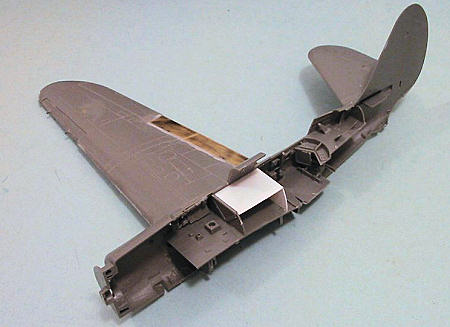 my previous review of the SB2C-4 kit.
my previous review of the SB2C-4 kit.
I started with the wings, since I wanted to glue them to the fuselage halves prior to the assembly of the fuselage.
I decided to keep the metal dive brakes and flaps, though I cut off the "sawtooth" trailing edges of the dive brakes. These left them with a gap once both upper and lower pieces were attached to the wing, which I filled with a piece of Evergreen strip, which I then faired in to the flap area with Mr. Surfacer 500 and Zap-A-Gap. I did this because I had found the last time I had tried this that the Evergreen sheet could become deformed if glued directly to the inner structure, or if that was cut out the Evergreen would not make a really solid surface.
I cut the rocket rails off their backing, then glued that in position on the lower wing. After sanding smooth, I covered it with Mr. Surfacer and when that was dry sanded everything smooth and rescribed the area.
I created the ammo chutes by heating a small screwdriver and then pushing it through the wing in the appropriate location. After cleaning that up, I backed up the holes inside the lower wing with Evergreen sheet. I then glued the wings together, filled in the area where the 20mm cannon would be attached with some Evergreen sheet, then drilled out two holes in the leading edge of each wing for the .50 caliber machine guns.
At this point I had a fortuitous accident, when I dropped the clear sprue and found it "the hard way" by stepping on it. Only a couple pieces were left unharmed. I contacted Accurate Miniatures and they said they would send a replacement. In the meantime, I still had the forward canopy section of the gunnerís rear compartment, and this was used to make the clear windows aft of the pilotís cockpit. I cut away the bulkheads aft of the pilotís cockpit and forward of the gunnerís cockpit, installed the basic interiors of each, and made the top of the fuel tank from Evergreen sheet.
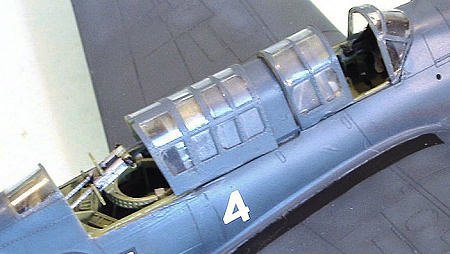 The canopy slide area of
the gunnerís cockpit had to be modified to make a straight slide, rather than
the one that dips down as is on the kit. I filled in that area with pieces of
Evergreen strip, applied Mr. Surfacer and sanded the area smooth, then rescribed
as necessary. I cut off the slider fairing on the canopy and modified the lower
edge of the sliding canopy so it too was straight. I used a bomb from the spares
box which I cut up and attached to the front of the raft container in the rear
cockpit, and installed that in the turtleback area. The area of the turtleback
immediately aft of the pilotís cockpit was cut away to shape for the early
Helldiver, and the clear part from the old Gunnerís canopy was used there to
create the open glass area.
The canopy slide area of
the gunnerís cockpit had to be modified to make a straight slide, rather than
the one that dips down as is on the kit. I filled in that area with pieces of
Evergreen strip, applied Mr. Surfacer and sanded the area smooth, then rescribed
as necessary. I cut off the slider fairing on the canopy and modified the lower
edge of the sliding canopy so it too was straight. I used a bomb from the spares
box which I cut up and attached to the front of the raft container in the rear
cockpit, and installed that in the turtleback area. The area of the turtleback
immediately aft of the pilotís cockpit was cut away to shape for the early
Helldiver, and the clear part from the old Gunnerís canopy was used there to
create the open glass area.
I also decided to close up the bomb bay, so I cut the doors free of the adjoining structure parts, and glued them to each fuselage half, reinforcing the joint on the inside with some Evergreen strip.
The cockpits were painted and installed per the instructions, using the kit parts. When these were done, I glued each wing to its respective fuselage half, then glued the fuselage halves together. I then attached the horizontal stabilizers, painted and attached the engine, and the cowling.
| COLORS & MARKINGS |
The wheel wells, landing gear and gear door interiors were painted with
Tamiya "Chromate Yellow," which is "Yellow Zinc Chromate. I used Xtracrylix
"white" for the lower color, and Gunze-Sangyo "Intermediate Blue" and "Navy
Blue" for the two upper colors.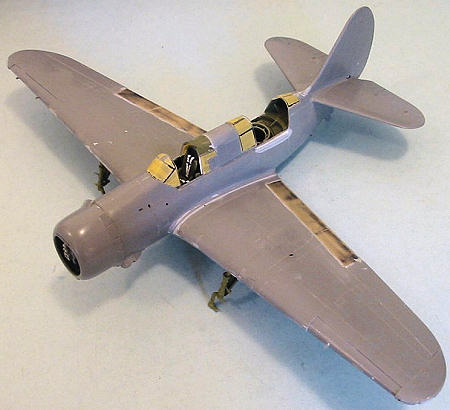
The kit decals for the fuselage insignia were too large, from studying photos of VB-17 Helldivers, so I used national markings decals from the decal dungeon. I also used different-sized numbers because the photo of VB-4 in the Osprey Helldiver book shows the number was on the vertical fin and on the fuselage ahead of the insignia, and was different size from the kit decals. I used the kit decals for the serial number and designator (after clipping off the final "C" in "SB2C-1C") and also used the wing decals. Not having access to the old Aeromaster sheet of stencils, I didnít stencil the model.
| FINAL BITS |
Photos in the two Helldiver books I have show that these VB-17 Helldivers hadnít had much opportunity to be "dinged" by the time of the Rabaul Raid (though the paint got seriously corroded from the salt air, as well as faded from the tropic sun over the course of their tour). I left the model pretty clean, other than exhaust stains and oil stains inside the wheel wells and on the landing gear and gear doors, which was created by spraying the area with Tamiya Smoke. The landing gear, prop and canopies were attached.
| CONCLUSIONS |
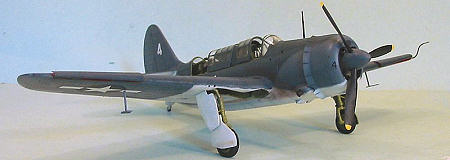 Fortunately the basic
Helldiver airframe stayed the same throughout its production life, so the
modifications to turn an SB2C-4 into an SB2C-1 are mostly in the area of minor
details, which any modeler with any amount of scratchbuilding experience can
easily accomplish. With its 3-bladed prop and wing without cannon, the first
Helldiver looks different from its descendants, and makes a valuable addition to
any collection of US Navy airplanes of the Second World War. The Beast may not
have been the best dive bomber ever built, but it has a distinctive look that I
for one have always appreciated.
Fortunately the basic
Helldiver airframe stayed the same throughout its production life, so the
modifications to turn an SB2C-4 into an SB2C-1 are mostly in the area of minor
details, which any modeler with any amount of scratchbuilding experience can
easily accomplish. With its 3-bladed prop and wing without cannon, the first
Helldiver looks different from its descendants, and makes a valuable addition to
any collection of US Navy airplanes of the Second World War. The Beast may not
have been the best dive bomber ever built, but it has a distinctive look that I
for one have always appreciated.
October 2006
Review kit courtesy of Accurate Miniatures.
Copyright ModelingMadness.com
If you would like your product reviewed fairly and fairly quickly, please contact the editor or see other details in the Note to Contributors.